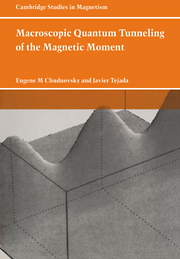Book contents
- Frontmatter
- Contents
- Preface
- Chapter I Introduction
- Chapter 2 Tunneling on a macroscopic scale
- Chapter 3 Magnetism in imaginary time
- Chapter 4 Magnetic tunneling in bulk materials
- Chapter 5 Quantum magnetic relaxation
- Chapter 6 Other experimental approaches
- Chapter 7 Tunneling in magnetic molecules
- References
- Index
Chapter I - Introduction
Published online by Cambridge University Press: 16 October 2009
- Frontmatter
- Contents
- Preface
- Chapter I Introduction
- Chapter 2 Tunneling on a macroscopic scale
- Chapter 3 Magnetism in imaginary time
- Chapter 4 Magnetic tunneling in bulk materials
- Chapter 5 Quantum magnetic relaxation
- Chapter 6 Other experimental approaches
- Chapter 7 Tunneling in magnetic molecules
- References
- Index
Summary
Traditionally, the physics of magnetism has been divided into two almost independent branches. The first branch deals with interactions at the atomic level. When applied to the three-dimensional world, it mostly consists of challenging unsolved problems like the Ising, Habbard, and Heisenberg Hamiltonians, Fermi-liquid models of itinerant magnetism, etc. It is concerned with the ground state and excitations relevant to small scales, typically a few tens of atomic lattice spacings. The Heisenberg ferromagnetic exchange, for example, leads to the formation of a constant local spin density and the quadratic dependence of the energy of short-wavelength spin excitations on the momentum. This has certain consequences for the saturation magnetization, its temperature dependence, the magnetic contribution to the specific heat, neutron diffraction, etc. However, when one turns to the properties of a magnet on a mesoscopic scale of 100 Å and greater, most of what can be derived or predicted from the microscopic theory becomes irrelevant. For instance, the practical question of how a piece of iron magnetizes in an applied magnetic field has nothing to do with the Heisenberg Hamiltonian. This is because processes observed on the mesoscopic and macroscopic scales result from weak interactions unaccounted for in simple quantum-mechanical models. They are the magnetic anisotropy owing to the symmetry of the crystal, the magnetic dipole interaction that breaks the magnet into magnetic domains, interactions of domain walls with defects, impurities, itinerant electrons, etc.
- Type
- Chapter
- Information
- Publisher: Cambridge University PressPrint publication year: 1998



